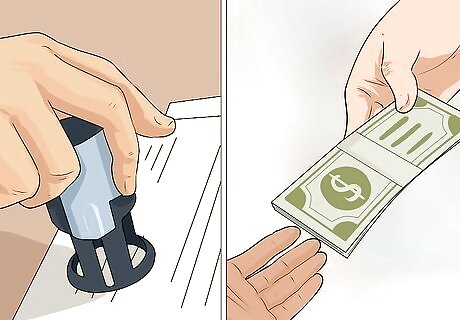
views
X
Research source
When someone violates your right to privacy, you have a legal claim. To make that claim, you need to gather evidence of the invasion and notify the defendant to cease and desist his or her behavior. If you want to take the next step and sue, then you should meet with a lawyer, who can advise you on your legal rights.
Identify possible violations.

Invasion of privacy is an area of law created by your state law. Each law is different, but there are generally four different ways that someone can invade your privacy: Someone intrudes on your solitude. When someone intercepts your communications or spies on you in your own home, then you probably have a legal claim. Your name or likeness is appropriated. When someone uses your name or likeness without your permission, then you can claim invasion of privacy. For example, if someone impersonates you in order to gain confidential information, then you may have a claim. Someone publicly discloses private facts. Where sensitive private information like your sexual orientation, financial difficulties, or medical history is publicly revealed, then you could claim a violation. You are represented in a false light. If information is published about you that is misleading and highly offensive, then you can claim a violation of privacy. For example, if a newspaper claims that you are pregnant when you are not, then you can possibly get money damages as compensation.
Write down the date and time of the invasion.

In order to claim an invasion of privacy, you need facts pertaining to the invasion. If someone has been spying on you, then write down the time of day and where the person is located. If someone has published private information or appropriated your likeness, the note where the information is published and when it has appeared publicly. Also try to get physical copies of the publication. Save newspapers and magazine articles and print off anything that appears on the web. Also keep track of the dates on which the offending information has appeared online.
Get witness information.

If anyone witnessed the violation, then you should take down their name and contact information. Also write down summaries of what they observed. Ideally, the witness will write out his or her own statement and sign it. If possible, try to get personal contact information (like a personal phone or email) instead of business contact information. People regularly leave jobs. It might be a year or two before you need someone to testify on your behalf.
Hold onto medical expense records.

Hang onto bills for any doctors or therapists you've had to see because of the privacy invasion. Depending on your state law, you can be compensated for a variety of harms: Mental stress caused by the invasion Medical expenses Economic harms caused by the public disclosure of private information (e.g., lost job opportunities or contracts) Disgorgement of any profits the defendant has made by invading your privacy Punitive damages to punish malicious intrusions on your privacy
Think about writing a cease and desist letter.

Your state may require that you send a notice to the violator. This letter demands that he or she desist from further violations. For example, if your landlord has come into your apartment without permission, then some states might require that you send a letter. Even if you are not obligated to send the letter, it is helpful to do so. By putting the defendant on notice, he or she can’t later claim to have innocently violated your privacy unknowingly.
Draft the letter.

Explain when the violations occurred as well as what the violations were. You also must make a demand that the violations stop. Set up the letter as you would a business letter. See Write a Business Letter for more information. In the first paragraph, explain the law. For example, if you are demanding that a landlord not come into your apartment without giving written notice, then explain the law: “State law requires that landlords give tenants 48 hours’ notice before entering the property, or 24 hours’ notice if showing the property to a prospective new tenant. The written notice must specify the exact date and time for entry.” In the next paragraph, list the dates your privacy was violated. “You entered my property on the following dates: [list the dates].” Conclude by threatening to bring legal action. “Under the law, I am entitled to sue for invasion of privacy. Please do not enter my unit in the future without permission.”
Mail the letter.

You should mail the letter certified mail, return receipt requested. Hold onto the receipt, as it is proof that the violator received your letter. Staple the signed return receipt to your copy of the letter so that you will be sure not to lose it.
Put up privacy signs.

You can also strengthen your case by installing privacy signs around your property. Clearly mark your boundaries. A defendant will be less likely to claim that he negligently invaded your privacy when you clearly notify people that no trespassing is allowed. Many companies sell No Trespassing signs on the Internet. You can also get them from a local hardware store.
Protect your private information.

Disclosing your information publicly makes it harder for you to launch a successful lawsuit. For example, a person who posted a picture on Instagram tried to sue for invasion of privacy when another person took his picture and reposted it. The judge threw out the lawsuit. Look to see what has been made public on your Facebook, Instagram, Pinterest, and other accounts. You should make your accounts private if you want to protect your information on those websites. Also read the terms of service for each social network that you use. Some of these state that other people can share or appropriate your images. If so, then you will not have a strong invasion of privacy claim.
Check if you can sue.

Read your state law and meet with an attorney. Not every state allows each claim for violation of privacy. To understand all of your rights, you should schedule a consultation with an attorney. An experienced lawyer will help you understand whether or not you can bring a lawsuit for invasion of privacy. They can also help you gather compelling evidence of the invasion. To find your state law, you can visit your nearest law library, which should be housed at the courthouse. To find a lawyer, you should visit your state bar association’s website, which should have information on how to find a lawyer. Many bar associations also run referral programs. You shouldn’t delay. States have statutes of limitations which require you to bring an invasion of privacy lawsuit within a certain amount of time. For example, in California you have two years to bring an intrusion upon seclusion claim. In Florida, by contrast, you have four years to bring an intrusion upon seclusion claim. To find the applicable statute of limitations for your claim, ask an attorney.
Draft a complaint.

If you want to sue, then you will need to start the lawsuit by filing a complaint. In this document, you allege the factual circumstances of the invasion of privacy and request relief. Many courts now have printed, “fill in the blank” complaint forms that you can use. Ask your court clerk if one is available. If no form is available, then search the Internet for samples that you could use. You might also use a CD or book of legal forms. See Format a Legal Pleading for information on the format and style of your complaint.
File the complaint.

You should file the complaint with the court in the county where the defendant lives. Make several copies of the completed complaint and take it to the clerk. Ask to file. The clerk should stamp all of your copies with the date as well. You will probably have to pay a filing fee, which will vary by court. If you can’t afford the filing fee, then ask the court clerk for a fee waiver form and fill it out.
Serve notice of the lawsuit.

Once you file a lawsuit, you must notify the defendant. You can provide proper notice by serving a copy of the complaint and a summons on the defendant. Ask the clerk for the summons. Notice can be served in a variety of ways, depending on your court’s rules: By first class mail. In some courts you can give the clerk money so that the clerk can mail the summons and complaint to the defendant. Personal service by sheriff or process server. For a fee, you can usually hire either the sheriff or a private process server to make personal delivery on the defendant. Prices will vary, but you can expect to pay $45-75 per service. Personal service by someone 18 or older. This person cannot be a party to the lawsuit. Other methods. Ask the court clerk for which methods are appropriate.


















Comments
0 comment